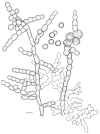Coniosporium epidermidis sp. nov., a new species from human skin
- PMID: 19287535
- PMCID: PMC2610297
- DOI: 10.3114/sim.2008.61.13
Coniosporium epidermidis sp. nov., a new species from human skin
Abstract
Coniosporium epidermidis sp. nov. is described from a superficial skin lesion with blackish discolouration in an 80-yr-old Chinese patient. The species produces dark, thick-walled, inflated, reluctantly liberating arthroconidia without longitudinal septa. Sequences of the ribosomal operon, as well as of the translation elongation factor 1-alpha support its novelty. The species is found in a lineage basal to the order Chaetothyriales, amidst relatives from rock, but also species repeatedly isolated from human skin and nails and eventually causing mild cutaneous infections. Coniosporium epidermidis is consistently found on humans, either asymptomatic or symptomatic. The species indicates a change of life style towards human pathogenicity, which is a recurrent type of ecology in derived Chaetothyriales. Superficial and cutaneous infection by melanized fungi is a new category in dermatology.
Keywords: Black yeasts; Coniosporium; superficial mycosis; taxonomy.
Figures





Similar articles
-
Black yeast-like fungi in skin and nail: it probably matters.Mycoses. 2012 Mar;55(2):161-7. doi: 10.1111/j.1439-0507.2011.02055.x. Epub 2011 Jul 8. Mycoses. 2012. PMID: 21736629
-
From the Tunnels into the Treetops: New Lineages of Black Yeasts from Biofilm in the Stockholm Metro System and Their Relatives among Ant-Associated Fungi in the Chaetothyriales.PLoS One. 2016 Oct 12;11(10):e0163396. doi: 10.1371/journal.pone.0163396. eCollection 2016. PLoS One. 2016. PMID: 27732675 Free PMC article.
-
New molecular marker for phylogenetic reconstruction of black yeast-like fungi (Chaetothyriales) with hypothetical EIF2AK2 kinase gene.Fungal Biol. 2020 Dec;124(12):1032-1038. doi: 10.1016/j.funbio.2020.09.007. Epub 2020 Sep 24. Fungal Biol. 2020. PMID: 33213783
-
Black Molds and Melanized Yeasts Pathogenic to Humans.Cold Spring Harb Perspect Med. 2014 Nov 10;5(8):a019570. doi: 10.1101/cshperspect.a019570. Cold Spring Harb Perspect Med. 2014. PMID: 25384772 Free PMC article. Review.
-
Superficial Phaeohyphomycosis Caused by Aureobasidium melanogenum Mimicking Tinea Nigra in an Immunocompetent Patient and Review of Published Reports.Mycopathologia. 2016 Aug;181(7-8):555-60. doi: 10.1007/s11046-016-9989-3. Epub 2016 Feb 16. Mycopathologia. 2016. PMID: 26883514 Review.
Cited by
-
Novel evolutionary lineages revealed in the Chaetothyriales (fungi) based on multigene phylogenetic analyses and comparison of its secondary structure.PLoS One. 2013 May 28;8(5):e63547. doi: 10.1371/journal.pone.0063547. Print 2013. PLoS One. 2013. PMID: 23723988 Free PMC article.
-
Letter: some caveats in skin bank practices from the perspectives of fungal skin flora.Int Wound J. 2011 Apr;8(2):211. doi: 10.1111/j.1742-481X.2010.00737.x. Epub 2010 Dec 17. Int Wound J. 2011. PMID: 21166999 Free PMC article. No abstract available.
-
Draft Genome Sequences of the Black Rock Fungus Knufia petricola and Its Spontaneous Nonmelanized Mutant.Genome Announc. 2017 Nov 2;5(44):e01242-17. doi: 10.1128/genomeA.01242-17. Genome Announc. 2017. PMID: 29097475 Free PMC article.
-
Fungal Planet description sheets: 1042-1111.Persoonia. 2020 Jun;44:301-459. doi: 10.3767/persoonia.2020.44.11. Epub 2020 Jun 29. Persoonia. 2020. PMID: 33116344 Free PMC article.
-
Case report: contamination of a drinking water distribution system by Exophiala-dominated biofilm in the Midwestern United States.J Water Health. 2025 Mar;23(3):314-321. doi: 10.2166/wh.2025.173. Epub 2025 Feb 7. J Water Health. 2025. PMID: 40156210
References
-
- Badali H, Carvalho VO, Vicente V, Attili-Angelis D, Kwiatkowski IB, Gerrits van den Ende AHG, Hoog GS de (2009). Cladophialophora saturnica sp. nov., a new opportunistic species of Chaetothyriales revealed using molecular data. Medical Mycology 47: 1–12. - PubMed
-
- Butin H, Pehl L, Hoog GS de, Wollenzien U (1996). Trimmatostroma abietis sp. nov. (Hyphomycetes) and related species. Antonie van Leeuwenhoek 69: 203–209. - PubMed
LinkOut - more resources
Full Text Sources
Molecular Biology Databases
